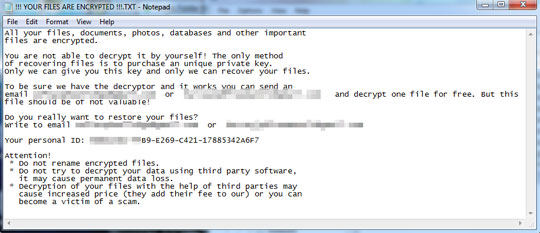Ransom.Win32.BURAN.THHOHAIA
Ransomware-GPQ!EF4E4CD02B95 (McAfee); HEUR:Trojan-Ransom.Win32.Gen.gen (Kaspersky)
Windows


Threat Type: Ransomware
Destructiveness: No
Encrypted: No
In the wild: Yes
OVERVIEW
This Ransomware arrives on a system as a file dropped by other malware or as a file downloaded unknowingly by users when visiting malicious sites.
It drops files as ransom note.
TECHNICAL DETAILS
Arrival Details
This Ransomware arrives on a system as a file dropped by other malware or as a file downloaded unknowingly by users when visiting malicious sites.
Installation
This Ransomware adds the following processes:
- chcp 1250 → changes console page to 1250
- net view → shows a list of computers and network devices on the network
- notepad.exe %Desktop%\!!! YOUR FILES ARE ENCRYPTED !!!.TXT
(Note: %Desktop% is the current user's desktop, which is usually C:\Documents and Settings\{User Name}\Desktop on Windows 2000(32-bit), XP, and Server 2003(32-bit), or C:\Users\{user name}\Desktop on Windows Vista, 7, 8, 8.1, 2008(64-bit), 2012(64-bit) and 10(64-bit).)
Other System Modifications
This Ransomware adds the following registry keys:
HKEY_CURRENT_USER\Software\Buran III\
Service
It adds the following registry entries:
HKEY_CURRENT_USER\Software\Buran III\
Service
Public Key = "{random characters}"
HKEY_CURRENT_USER\Software\Buran III\
Service
Machine ID = "{random characters}"
Other Details
This Ransomware does the following:
- It terminates itself if the language of the target machine is any of the following:
- Ukrainian
- Belarusian
- Russian
- Kazak
Ransomware Routine
This Ransomware avoids encrypting files with the following strings in their file name:
- boot.ini
- bootfont.bin
- bootsect.bak
- desktop.ini
- ctfmon.exe
- iconcache.db
- master.exe
- master.dat
- ntdetect.com
- ntldr
- ntuser.dat
- ntuser.dat.log
- ntuser.ini
- thumbs.db
- !!! your files are encrypted !!!.txt
- .bat
- .cmd
- .com
- .cpl
- .dll
- .msc
- .msp
- .pif
- .scr
- .sys
- .log
- .exe
- .lnk
- .buran
It avoids encrypting files found in the following folders:
- :\$RECYCLE.BIN\
- :\$Windows.~bt\
- :\RECYCLER
- :\System Volume Information\
- :\Windows.old\
- :\Windows\
- :\intel\
- :\nvidia\
- :\inetpub\logs\
- \All Users\
- \AppData\
- \Apple Computer\Safari\
- \ApplicationData\
- \Boot\
- \Google\
- \Google\Chrome\
- \Mozilla Firefox\
- \Mozilla\
- \Opera Software\
- \Opera\
- \Tor Browser\
- \Common Files\
- \Internet Explorer\
- \Windows Defender\
- \Windows Mail\
- \Windows Media Player\
- \Windows Multimedia Platform\
- \Windows NT\
- \Windows Photo Viewer\
- \Windows Portable Devices\
- \WindowsPowerShell\
- \Windows Photo Viewer\
- \Windows Security\
- \Embedded Lockdown Manager\
- \Windows Journal\
- \MSBuild\
- \Reference Assemblies\
- \Windows Sidebar\
- \Windows Defender Advanced Threat Protection\
- \Microsoft\
- \Package Cache\
- \Microsoft Help\
- \Desktop\
It appends the following extension to the file name of the encrypted files:
- .{{8 random characters}-{4 random characters}-{4 random characters}-{4 random characters}-{12 random characters}}
It drops the following file(s) as ransom note:
- %Desktop%\!!! YOUR FILES ARE ENCRYPTED !!!.TXT
- {Encrypted Directory}\!!! YOUR FILES ARE ENCRYPTED !!!.TXT
(Note: %Desktop% is the current user's desktop, which is usually C:\Documents and Settings\{User Name}\Desktop on Windows 2000(32-bit), XP, and Server 2003(32-bit), or C:\Users\{user name}\Desktop on Windows Vista, 7, 8, 8.1, 2008(64-bit), 2012(64-bit) and 10(64-bit).)
It leaves text files that serve as ransom notes containing the following text:
SOLUTION
Step 1
Trend Micro products with the XGen technology detect this malware as
- Troj.Win32.TRX.XXPE50FFF031
Step 2
Before doing any scans, Windows 7, Windows 8, Windows 8.1, and Windows 10 users must disable System Restore to allow full scanning of their computers.
Step 3
Identify and terminate files detected as Ransom.Win32.BURAN.THHOHAIA
- Windows Task Manager may not display all running processes. In this case, please use a third-party process viewer, preferably Process Explorer, to terminate the malware/grayware/spyware file. You may download the said tool here.
- If the detected file is displayed in either Windows Task Manager or Process Explorer but you cannot delete it, restart your computer in safe mode. To do this, refer to this link for the complete steps.
- If the detected file is not displayed in either Windows Task Manager or Process Explorer, continue doing the next steps.
Step 4
Delete this registry key
Important: Editing the Windows Registry incorrectly can lead to irreversible system malfunction. Please do this step only if you know how or you can ask assistance from your system administrator. Else, check this Microsoft article first before modifying your computer's registry.
- In HKEY_CURRENT_USER\Software\Buran III
- Service
Step 5
Delete this registry value
Important: Editing the Windows Registry incorrectly can lead to irreversible system malfunction. Please do this step only if you know how or you can ask assistance from your system administrator. Else, check this Microsoft article first before modifying your computer's registry.
- In HKEY_CURRENT_USER\Software\Buran III\Service
- Public Key = {random characters}
- In HKEY_CURRENT_USER\Software\Buran III\Service
- Machine ID = {random characters}
Step 6
Search and delete these files
- %Desktop%\!!! YOUR FILES ARE ENCRYPTED !!!.TXT
- {Encrypted Directory}\!!! YOUR FILES ARE ENCRYPTED !!!.TXT
Step 7
Scan your computer with your Trend Micro product to delete files detected as Ransom.Win32.BURAN.THHOHAIA. If the detected files have already been cleaned, deleted, or quarantined by your Trend Micro product, no further step is required. You may opt to simply delete the quarantined files. Please check the following Trend Micro Support pages for more information:
Step 8
Restore encrypted files from backup.
Did this description help? Tell us how we did.


